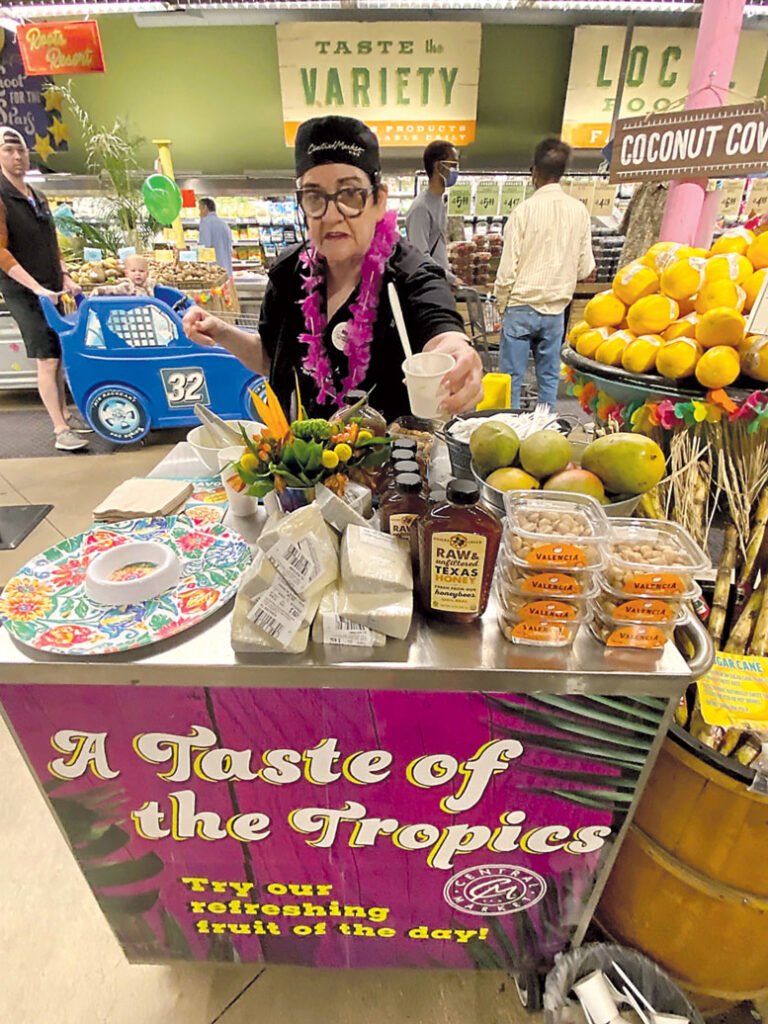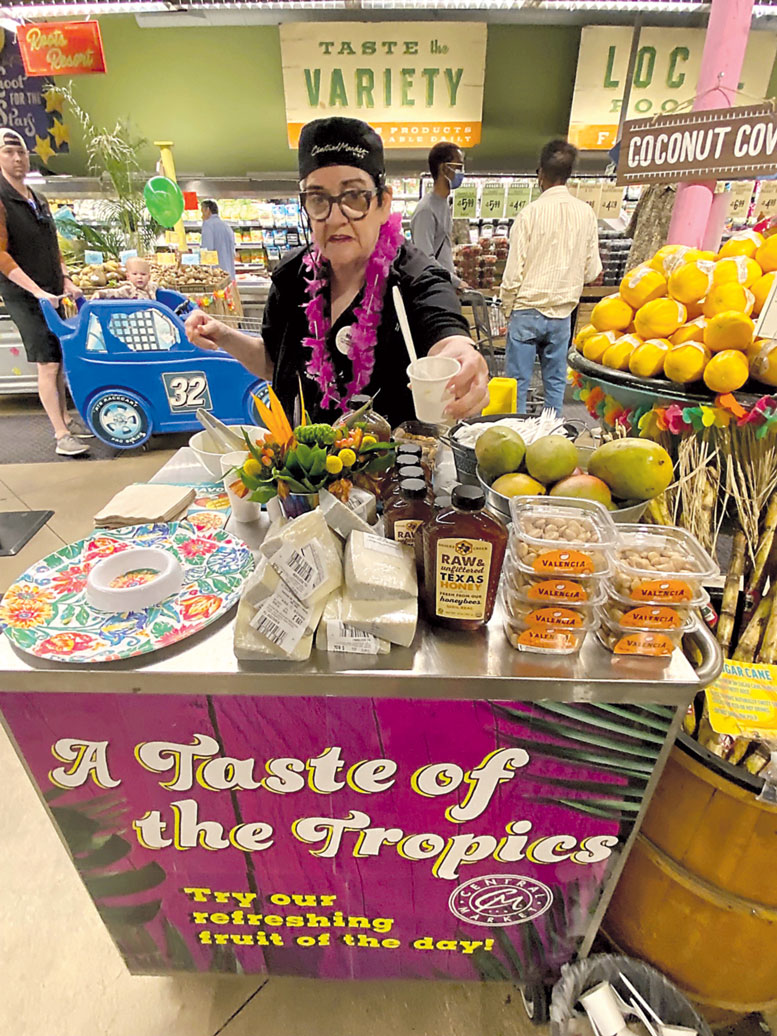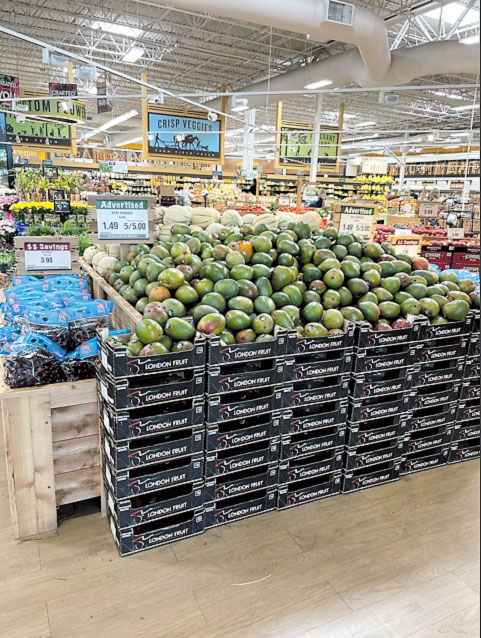Mexican Mangos — Top Five Challenges and Opportunities
February 27, 2024 | 9 min to read
In 2023, Mexico achieved a record mango harvest of over 2.23 million tons, marking a 40% increase over the past decade, according to the Secretariat of Agriculture and Rural Development. Dominating the U.S. market with a 65.5% share, Mexico is vital for mango supply, especially during peak season from February to September. Challenges include weather impacts and competition for retail space, although rising consumer demand and organic offerings present growth opportunities.

Mexico harvests record volume, an increase of 40%.
Originally printed in the February 2024 issue of Produce Business.
Mexico is a powerhouse producer of mangos. In 2023, it harvested a record volume of 2.23-plus million tons of this tropical fruit, according to the Secretariat of Agriculture and Rural Development (SADER), in Mexico City. This represents an increase of nearly 40% in the last decade (2013-2023), based on data from the country’s Agri-Food and Fisheries Information Service.
At the same time, Mexico is the No. 1 supplier of mangos to the U.S., with a 65.5% market share, according to the U.S. Department of Agriculture (USDA) Agricultural Research Service statistics from March 2023.
Put these two facts together and it’s clear to see Mexico plays the starring role in supplying Americans with this sweet, juicy fruit.
“Mexico is a critical supplier for us, particularly from February to September, when their mangos are in peak season, and because of their proximity, which allows for fresher produce, reduced environmental impact, and lower transportation costs,” says Chris Harris, category director for produce at New Seasons Market, a 20-store chain headquartered in Portland, OR.
“There’s a clear uptrend in consumer interest for fresh mangos, with demand peaking during the spring and summer.”
This rosy picture isn’t without its challenges. Weather, organic demand, new varieties, sufficient retail shelf space, and dialed-in promotions are all potential pitfalls that can instead become profit generators.
1. EL NIÑO WEATHER — FAMINE TO FEAST
The relative lack of mangos in the U.S. from late 2023 until early 2024 means the volume surge with the start of the 2024 Mexican season will be most welcome.
In the immediate offshore season, Peru, Ecuador and Brazil had production issues, according to Chris Ciruli, chief operating officer of Ciruli Brothers LLC, in Rio Rico, AZ.
“Between October and January, we saw some of the shortest, and most unstable, markets in the last 20 to 25 years due to a lack of production and lower imports from these countries,” Ciruli says. “The El Niño phenomenon compromised the production areas, causing severe delays and an estimated 80% reduction in mango production from Ecuador and Peru. Quality was also negatively impacted in Ecuador and Peru due to higher rainfall.”
Although Mexico was also affected by El Niño, which forced a more natural bloom cycle with higher rainfall in the fall months, it did not compromise fruit quality in the southern part of the country, says Ciruli.
In 2023, the U.S. saw a 10% increase in Mexican mango imports, says Norma Mesias, marketing coordinator for Cabefruit Produce LLC, in McAllen, TX. This season, “while our partners in South America bounce back from a slower crop, we can cover their demands with this surge in volume.”
The primary mango growing areas in Mexico are in the southern states. The season starts in February in Oaxaca and Chiapas, then works north along Guerrero, Michoacán, Jalisco, Nayarit and Sinaloa, where the crop wraps up in mid-September. These states provide the best climate conditions and soil attributes for commercial mango production, as well as infrastructure like packing houses.
“Mexico’s multiple growing regions contribute to a consistent supply of mangos all season long,” says Gary Clevenger, co-founder and managing member of Freska Produce International LLC, in Oxnard, CA. “Oaxaca has mostly Tommy Atkins from February to March, Sinaloa regions have Tommys starting in late April and the Kents start in mid-May.”
The Northern Sinaloa end-of-season crop out of Los Mochis is recognized for its excellent quality, large-sized, sweet-tasting mangos from August to September, says Cindy Schwing, vice president of marketing for Splendid by Porvenir, in Nogales, AZ.

PHOTO COURTESY SPLENDID BY PORVENIR
“This region produces ‘Jaguars’ (Ataulfos), Kents and Keitts. The ‘Keitt Kong’ has earned its reputation, and many retailers are already talking about this particular product,” says Schwing.
Looking ahead, most U.S.-based importers will start bringing in Mexican mangos by mid-February.
“The Mexican mango season is experiencing a slow start in volume due to colder weather down south, with flowering delayed by approximately two weeks,” says Amanda Horney, in sales and marketing at London Fruit Inc., in Pharr, TX. “We project the overall volume to be like that of 2023, and anticipate a pickup in volume around mid-March. It’s worth noting that sizing might be smaller at the beginning of the season.”

PHOTO COURTESY LONDON FRUIT, INC.
Mango prices will remain at an all-time high due to weather conditions in South America, says Clevenger. However, he anticipates prices will level by March or April.
Peak production this upcoming season should be from May to July, adds Jiovani Guevara, global grower development manager at C.H. Robinson, in Eden Prairie, MN, a division of C.H. Robinson. “That makes these months the best time for retailers to promote aggressively.”
2. FEEDING ORGANIC DEMAND
The demand for organic mangos is picking up as younger generations opt to consume more organic products, says Denise Gomez, marketing assistant at J&C Tropicals, in Miami, FL. She adds that organic Mexican mango production has increased from 13,758 metric tons in 2018 to 32,388 metric tons in 2022.
To meet this demand, Robinson Fresh has expanded certifications with current and new growers in Mexico. “Year over year, we continue to add organic certified growers to our portfolio of Mexican mango supply,” says Guevara.
Crespo Organic Mangoes, the Mexican organic mango brand from El Grupo Crespo/RCF Distributors in Rio Rico, AZ, is one of the largest producers of organic Ataulfo mangos, a Mexican cultivar recognized by its bright yellow skin. Fruit will start in February, in all sizes, with greater volumes of small fruit at the start. Supply is projected to last until early August. The company’s organic Ataulfos are available in many packaging SKUs.
Crespo also grows organic Tommy Atkins, Keitt, Haden and Kent mango varieties.
3. TRIED-AND-TRUE & NEW VARIETIES
Tommy Atkins is the No. 1 variety of mango sold in the U.S., representing 36% of total mango sales. Ataulfo is second at 28%; Kent, third at 26%, Keitt, fourth at 7%; and Haden, fifth at 3%, as per data shared by Albert Perez, chief executive officer and director of grower relations for Continental Fresh LLC, in Miami, FL, and chairman of the National Mango Board.
New Seasons Market offers several mango SKUs that vary depending on the season, says Harris. “The types of mangos rotate between round types, like Tommy Atkins, Haden and Keitt, as well as the Ataulfo mangos.”
In addition to round Keitts and Kents, as well as Ataulfos, Tops Friendly Markets also offers an organic round mango, and an in-store overwrapped tray with five small, conventionally grown mangos, according to Jeff Cady, director of produce and floral. “The latter appeals to those shoppers who prefer a fixed price point.”
One of the biggest opportunities to sell more Mexican mangos is to provide multiple varieties with different flavor profiles.
“Larger chains commonly miss the opportunity to merchandise multiple varieties. There are months when Mexico offers three varieties concurrently, but many of the bigger retail chains usually carry only one variety on display,” says Ciruli.
Research is underway to produce new innovative varieties of mangos, according to Greg Golden, partner and sales manager at Amazon Produce Network LLC, in Vineland, NJ. “Some methods use genetic markers to give the specific traits desired, rather than more time-consuming, trial-and-error breeding.”
The Mallika Indian variety mango and Thai varieties Nam Doc Mai and Kiew Savoy are grown both conventionally and organic in Mexico by Crespo Organic Mangoes. They start harvest in April and are available through the summer, according to Nissa Pierson, who manages sales and marketing for Crespo Organic.
“PLU numbers do not exist for any of the specialty varietals and so we created unique and opulent banded tags for our specialty mango line, loaded with point-of-purchase, varietal-specific mango education and recipes, like our Thai Green Mango salad, all instantly accessible through QR codes on the tags.”
“Over the next decade, I think we’ll see growth of up to 10 to 15 commercially produced varieties, rather than the six or seven of today,” says Ronnie Cohen, principal of Vision Global Group LLC, in Hackensack, NJ.
4. GIVE ENOUGH RETAIL SHELF SPACE
During the high season from March to September at New Seasons Market, “we focus on creating high visibility displays using box stacks that draw attention. We particularly emphasize Ataulfo mangos with stand-alone promotional displays,” says Harris.
The biggest challenge to selling more Mexican mangos is fighting for prominent retail shelf space and competition with other items being promoted at the same time, according to Splendid by Porvenir’s Schwing.
“Mangos fit nicely into tropical displays, but also can be considered the ultimate stone fruit and merchandised with other stone fruits in the summertime. Additionally, there are still consumers who do not understand how to pick or cut a mango.”
Schwing says through resources from the National Mango Board and getting the word out through social media platforms, the industry has been able to overcome many of these issues by directing consumers to online videos, how-to instructions and recipes.
Horney at London Fruit hopes to see a resurgence of in-store sampling, particularly in the Midwest. “There’s a significant opportunity for education and growth in mango consumption in this area.”
5. DIAL IN PROMOTIONS
While the biggest challenge to selling more mangos is the weather, which cannot be controlled, “another is getting promotions with retailers to align with the period when the crop peaks,” says Ciruli. “For example, retailers have seen incredibly reclining sales volume between quarters 4 and 1. Now, they will look for ads and promotional volume between March and April, especially in preparation for Cinco de Mayo promotions.”
There is always a price challenge for retail to find the right mix of price and foreseen “promotional” value, adds Freska’s Clevenger. “But mangos have come a long way, and they still have a way to go. They are the most eaten fruit in the world, and here in the U.S., it will be there eventually.”
Being nimble in promotions will be especially important this season.
“The Mexican mango industry is made up of many small growers who are going to want the higher prices at the start of the season to last as long as possible,” says Amazon Produce Network’s Golden. “But sometime in April, pricing could change on a dime.”
He urges retailers to be ready to take advantage of this quickly with tools such as short-term digital promotions. Amazon Produce Network provides retail promotional funds to promote its Bella Brand mangos.
An increase in promotions with a hot price has helped to steadily drive mangos mainstream at Tops Friendly Markets, says Cady.
Seasonal peaks in Mexican mango production often correspond to Easter, Cinco de Mayo, Memorial Day, June for Mango Month, the Fourth of July, July 22 for Mango Day and Labor Day, says Splendid by Porvenir’s Schwing.
“June is always looked upon as an ideal month to plan high-volume ads. Often missed times to promote are end-of-season, North Sinaloa mangos. Some retailers will move to off-shore (Brazil) sooner than they need to, as they do not realize the larger Keitts are still available to them,” says Schwing.

